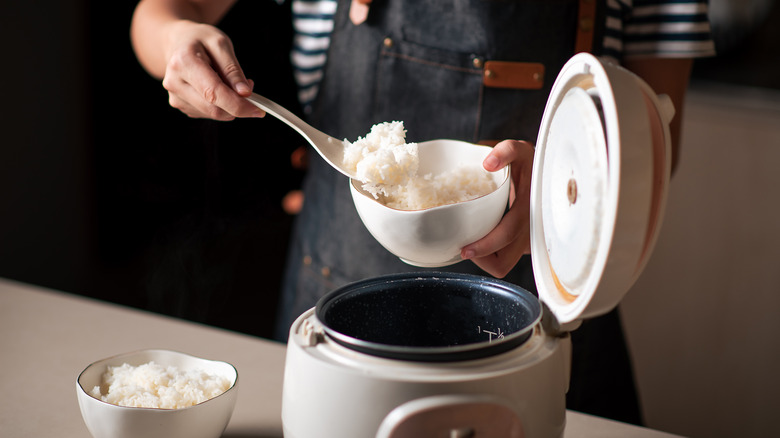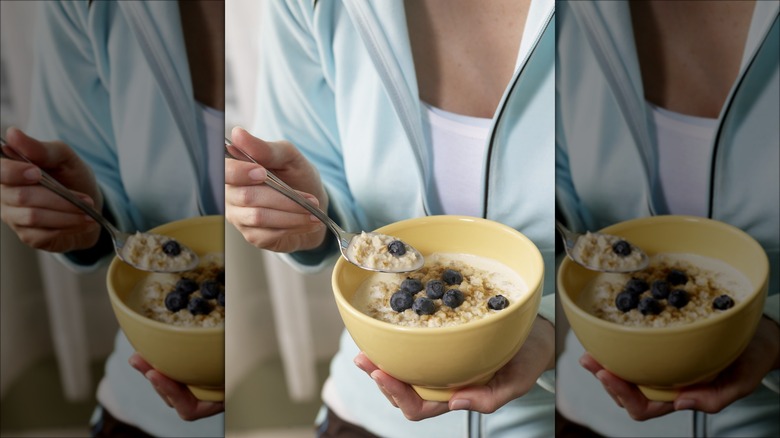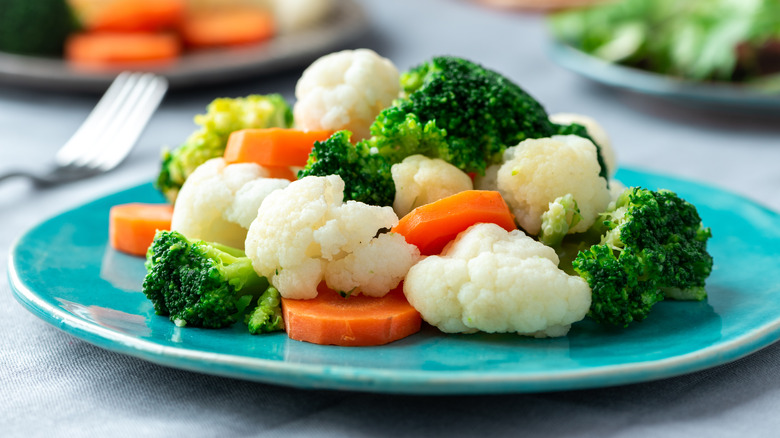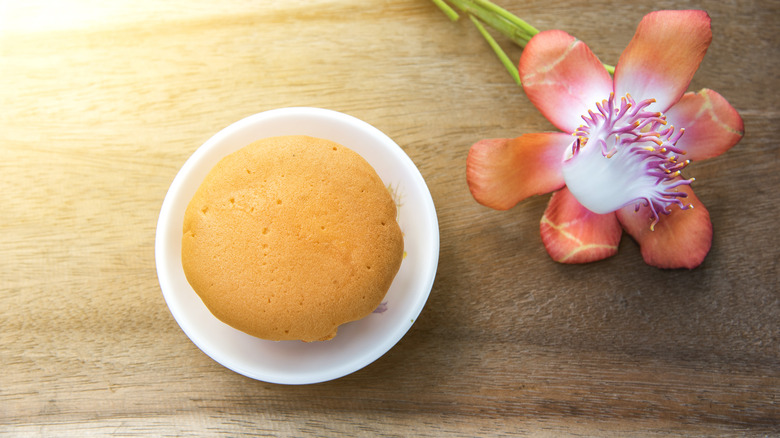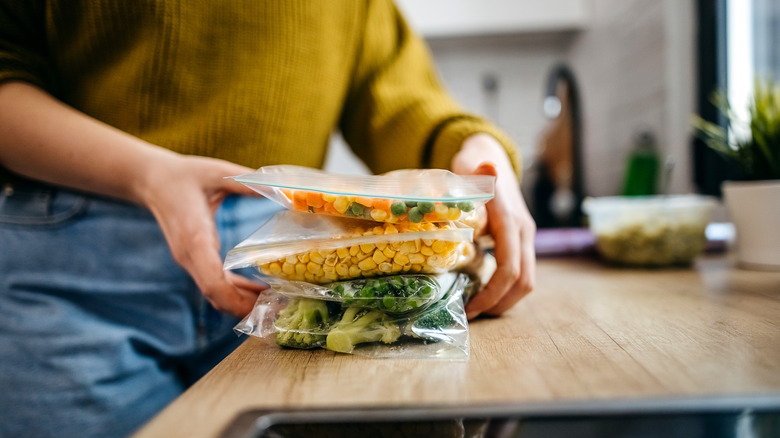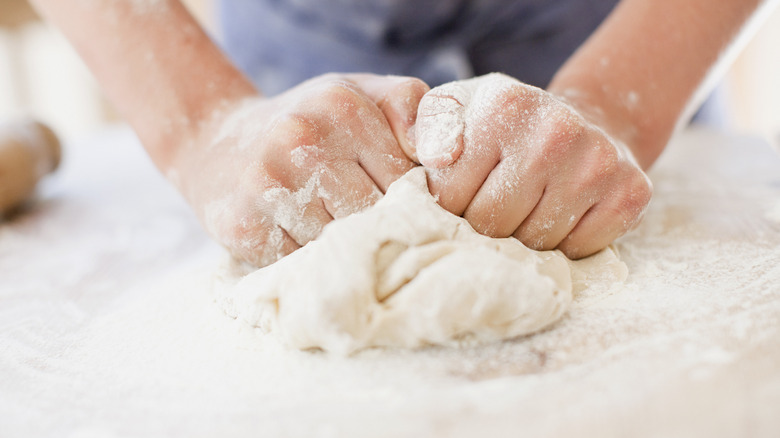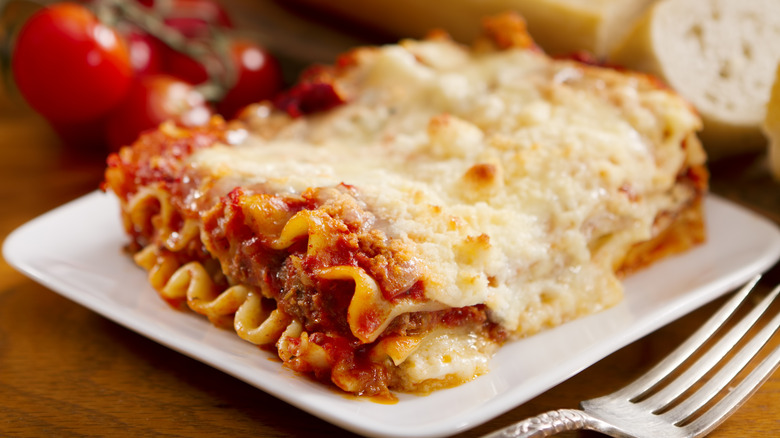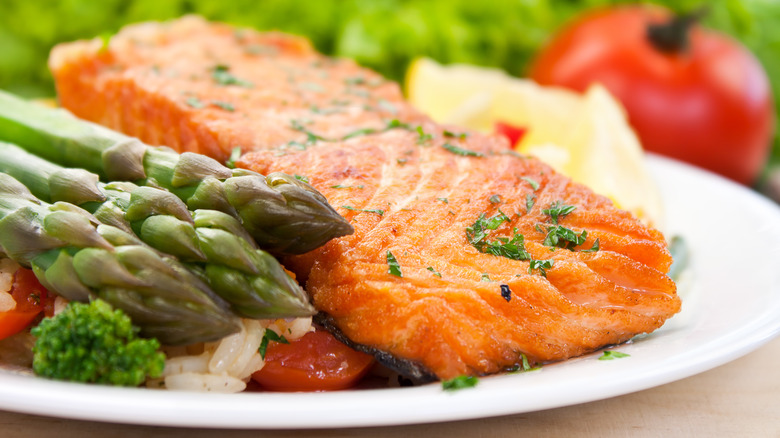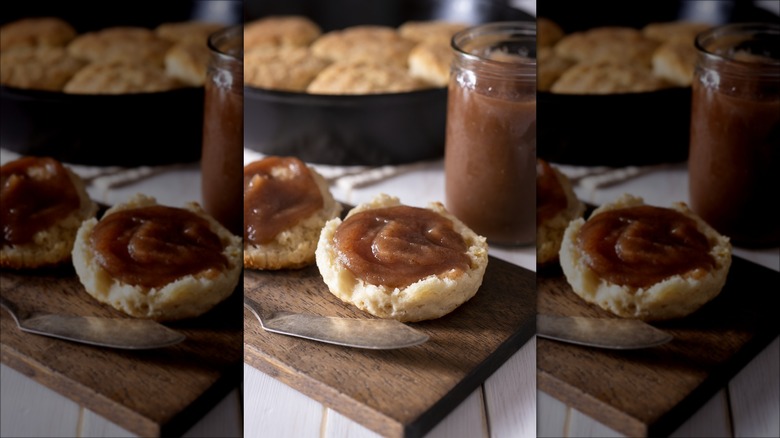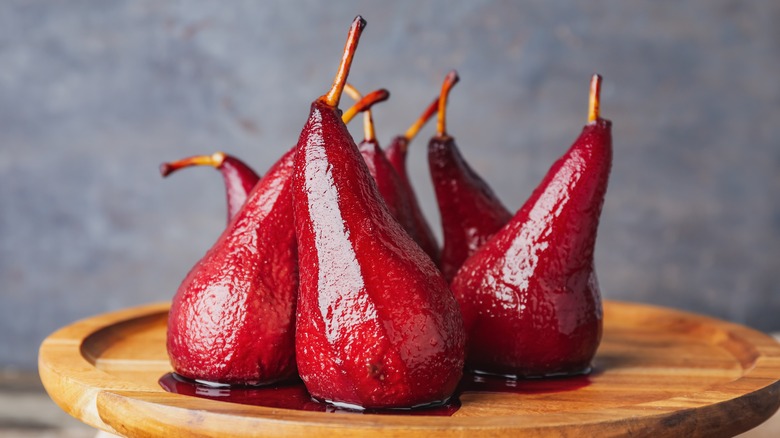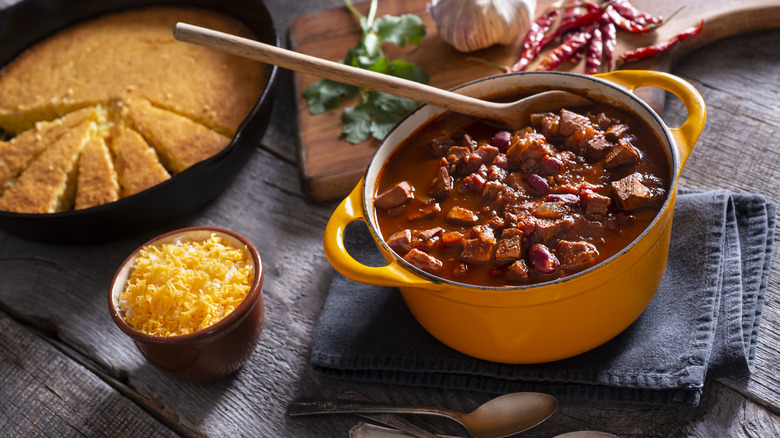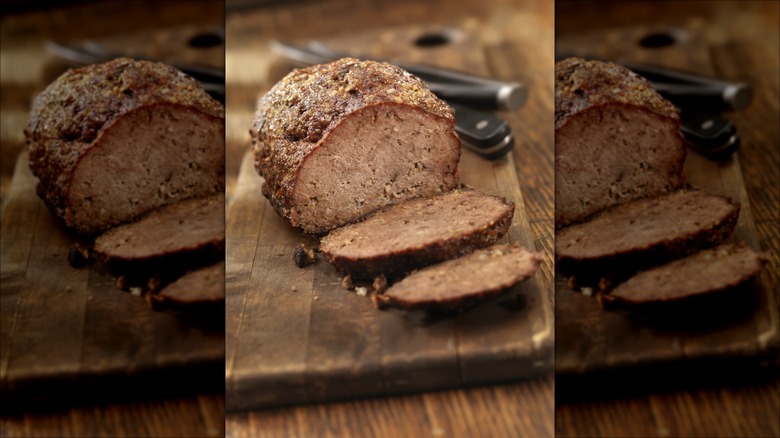12 Foods You Should Try Making In Your Rice Cooker
At a time when gadgets like Instant Pots sit eagerly awaiting use on kitchen counters almost everywhere, why would someone make anything but steamed rice in their rice cookers? The reasons vary. Some want to expand their repertoire with their current rice cooker, and others are just curious about what their plain ol' rice cooker can do. Fortunately, even though it's not the Swiss Army Knife of cookers, the average rice cooker still offers more versatility than many home cooks expect. This is true even for rice cookers that only offer single-click cooking settings.
Rice cookers, like slow cookers, are kitchen gadgets that many home cooks own, which suggests a certain comfort level with them that may not be present with a multi-cooker, like an Instant Pot. Plus, the rice cooker's simplicity makes it kid-friendly. Youngsters just learning their way around the kitchen can start experimenting with recipes without worrying about the hazards of cooking. So, these 12 foods are the chance to turn a simple rice cooker into an impressive kitchen tool, whether you're a novice cook or a bonafide home chef with years of experience.
1. Morning oatmeal
There is a reason that oatmeal remains a timeless breakfast staple. It's tasty, particularly with additions like half-and-half, fresh-cut fruit, a pat of butter, and a pinch of salt. All in all, it's a convenient, quick breakfast that's made all the more convenient and quicker if you cook the oatmeal in the rice cooker as you go about your morning routine. As with rice, the rice cooker gets the oatmeal water to bubbling and then moves on to a steamed-it-until-it's-done mode.
Depending on your rice cooker, you may have to check it a few times in the process, particularly if you have a single on/ off option. You may also want to experiment with more or less water until you land on a consistency that you like. Steel-cut oats work best for oatmeal-in-the-rice-cooker recipes because they keep their texture while absorbing the water. Finally, add ingredients like salt or garlic to the water to allow the flavor of the oats to seep in as they cook just as you would if you were cooking them on the stove. Or cook in dried fruits, nuts, and other additions to make something closer to a basic porridge.
2. Steamed veggies
When it comes to the steamed veggies versus boiled debate, steaming wins, hands down. Steaming doesn't leach out the nutrients, like vitamin C and B vitamins (and others), in the same way that boiling does. Keeping more of those nutrients in your diet means your body has an easier time transporting oxygen to the cells, putting the kibosh on inflammation, and bolstering the immune system. There's another bonus in this equation, too. And perfectly steamed veggies often just taste better than their boiled counterparts because the flavor doesn't get boiled out of them, either.
Many ricer cookers come already equipped with a steam basket, but even a rice cooker without a steam basket can become a steamer as a small steam basket will, on average, only set you back about $10. Aside from making cooking and clean-up easier, steaming your veggies in the rice cooker has a certain logic to it. Many modern rice cookers come with a timer on them, allowing you to cook food to the exact specifications required. But, even if you own a cooker with just the on/ off switch, you still have an advantage because you can make dinner in a variety of non-kitchen settings, like college dorm rooms. Just keep an eye on the steamer to ensure that the veggies don't overcook.
3. Make a cake
In many places in the world, home cooks keep little cakes and cookies on hand in case guests drop by. Because modern life is often too busy, this practice has either fallen out of favor entirely or the home-baked treats get replaced by off-the-rack, store-bought sweets. An average rice cooker on the counter, a box of cake mix, and a little ingenuity bring the from-scratch cake back as an option for those who like to keep food for company.
Baking a cake with a rice cooker produces a cake that, from a consistency standpoint, is slightly different than a cake baked in the oven. That said, it still tastes good, and this little cooking hack comes with more of a bonus than just convenience. It's a safe way to introduce kids to cake baking because opening and closing a hot oven or dealing with hot cake pans isn't required. Additionally, because a version of this cake can be made from pancake batter, it's less intimidating for the beginner baker. Finally, depending on your rice cooker, you're not limited to plain cakes. Your rice cooker can cook different types of cake, even pineapple upside-down cake, giving you plenty of options come baking time.
4. Reheat leftovers
The absence of a microwave doesn't mean you have to eat cold leftovers, at least not if you happen to have a rice cooker nearby. In some respects, rice cookers were made for leftovers because you usually have to sprinkle a little water on leftovers to keep them from drying out as you reheat them. Most rice cookers come with a non-stick basket that heats evenly on all sides, allowing you to disperse the steam from the water evenly throughout your food, making it less likely that you end up with dried reheated food.
Some single-person rice cookers offer you some additional space-saving benefits that even most smaller microwaves don't have. It's for this reason that many RVer's swear by this method of food warming. In warmer climates, the rice-cooker-as-food-warmer also offers the additional benefit of not heating up the whole house when you just want to heat up some leftover mac and cheese or beef stew. Because rice cookers vary in function, you may have to experiment a bit to see how long it takes to cook different leftovers in the rice cooker, just as you would with a microwave you've not cooked food in yet.
5. Cook eggs
Eggs cook quickly, and therefore, must be watched almost at all times during the cooking process. However, the rice cooker can stand between you and icky, overcooked eggs, while not having to watch the whole process.
First, many cookers come with a steam basket, which makes cooking poached eggs a less messy affair. All you need to do is drop a small cup – one large enough to fit one egg — into the steamer basket crack the egg into it and fill the rice cooker with water until it's just below the steam basket. The steam from the cooker will eventually cook the egg with no breaks in the egg. Second, the shape of the cooker and its ability to be heated uniformly throughout it makes for nicely shaped frittatas and classic omelets. Just pour your scrambled eggs, cheese, and whatever veggies you like into an oiled rice cooker pot, set the timer, and wait!
Finally, as you might have guessed, hard-boiled eggs are a natural for the rice cooker method, too. Fill the cooker with water and place your eggs in — fully immersing the eggs is unnecessary because of the steaming option. Plus, you usually won't get cracked eggs with this method. Allow the cooker to come to a boil, let the eggs cook, and once the boiling stops, allow the eggs to continue to cook in the steaming water. Then, drop them into an ice bath as usual.
6. Bake weekend bread
If you're looking for artisan bread that looks and tastes like it came from an oven in Italy, you probably won't get that result from baking your bread dough in the rice cooker. What you'll get is a round loaf of bread that's a cross between a Chinese steam bun and a soft dinner roll in consistency. If you like an adventure in cooking and you just want to see what this is all about, this bread experiment has your name on it.
As far as bread recipes go, this one takes a pretty standard, flour-yeast-milk mixture. It's the baking part that's unconventional. Between the rising, the kneading, and the baking, it'll take you several hours to make this bread. It also needs to be turned over a time or two during the cooking time. It bakes for about an hour on each side, though cooking times may vary depending on the type of cooker you have. You'll flip it one more time onto the original side before it's done, so it'll bake for about an hour and a half total.
7. Enjoy an easy lasagna or pasta recipe
Some pasta recipes, like lasagna or goulash, epitomize the one-pot meal concept, even if, in lasagna's case, that pot is actually a pan in the oven. Still, the underlying principle holds true. You toss a bunch of ingredients, including pasta, tangy red sauce, some meat — if you eat it — cheese, and some water, and go. Ideally, you have only one, possibly two pots to clean at dinner's end. For many busy home cooks, this makes cooking at home instead of ordering out a much more palatable idea because it simplifies the cooking process and the clean-up.
Because the sides of the steamer pot heat up, even layered pasta dishes, like lasagna, cook evenly all the way through. This feature also means that if you prefer not to cook the lasagna noodles first but want to allow them to soften in the juices from the sauce, meat, and cheese, you don't have to worry about the pan not being deep enough to capture the liquids. The steam stays inside the cooker, too, doubly ensuring that your pasta cooks all the way through and is moist to boot. But, rice cooker pasta isn't limited to lasagna. Other pasta dishes, like mac and cheese, make for ideal rice cooker pasta recipes, too. In this case, just boil the water and the pasta in the cooker before adding other ingredients. No rinsing the pasta is required.
8. Steam chicken or fish
For those who are looking after their health, switching from fried fish and chicken to steamed fish and chicken is one way to enjoy these proteins without the added cholesterol, fat, and preservatives that come with fried foods. Steaming chicken or fish in the rice cooker using the cooker's steam basket offers you a simple way to incorporate more steamed chicken or fish into your diet.
Some of the more advanced rice cookers have a separate "steam" option, but if yours doesn't, you can experiment a bit with cook times until you learn what works for your on/off cooker type. Usually, cutting into the chicken or fish during the cooking process will give you some pretty solid info on how done it is just as it. Despite some of the drawbacks of this method, its advantage over the stove comes down to your ability to set it and forget it once you iron out the kinks in the cooking process.
Like most of these types of recipes, adding your favorite marinades and seasoning makes the recipe taste better. For those, you follow the instructions for making chicken or fish with marinade. This holds true for seasoning the meat as well. After you become adept at cooking with this method, you can move on to one-pot meals, like steamed chicken or fish with vegetables and rice.
9. Whip up some apple butter
Although the cooking process for apple butter begins in a similar fashion to cooking applesauce, there are some key differences, namely the time involved and perhaps the amount of spices that you put into the recipe, depending on your tastes. You'll need to cook the chopped apples and spices in the rice cooker past the point of them being applesauce. This should be for about two hours in the cooker before the mixture needs to be removed, tossed in a blender for a few minutes, and then returned to the cooker for another hour. It's the longer cooking time that caramelizes the apples and the spices, turning this concoction into something that you spread on a roll with a pork chop dinner instead of as a side to the pork chops.
As far as ingredients are concerned, aside from apples, traditional apple butter gets spices like cinnamon and cloves, a little sugar, and depending on the chef, a little butter. Once it's done, it keeps in the fridge for about a month. Serve it on toast, biscuits, or in hot cereal to add a bit of autumn spice to your meals.
10. Poach fruit
Desserts like poached pears or apples bring a light and uplifting end to what may be an otherwise heavy dinner. Popularized in some of the wine regions of France, poached fruit turned less-than-desirable fruits from harvest into impressive showstoppers. While immersing pears in regional wines during the cooking process might sound rather complicated, it doesn't need to be.
In a rice cooker, the fruits take less than an hour to cook, though they should be left to warm in the cooker for another couple of hours and turned a couple of times to ensure they're cooked to yummy perfection. And, although traditional poached fruit recipes often call for wine, fruit juices like pomegranate and apple cider also work well. Spices that complement apples or pears, like cinnamon, cloves, or allspice, bring out the flavor of the fruits while at the same time providing a juxtaposition for sweet vanilla ice cream.
11. Make some chili
Homemade chili offers a budget way to turn your leftover veggies, beans, and meats into a warm, satisfying stew. And, for those cooking in places without traditional kitchens — like students — the compactness of the rice cooker with an on/off button makes for both an easier and less hazardous chili.
While it's possible to cook dry beans in a rice cooker, if you're pressed for time, start with canned beans. A taco seasoning flavor packet gives a basic chili recipe the necessary spicy kick, though adding more unusual ingredients to your chili like beer, fish sauce, or dark chocolate adds some pizzazz on nights when you're feeling a greater sense of culinary daring.
Typically, you'll cook this concoction on the "white rice" setting. Some stirring may be required. If you start with dried beans, they'll have to soak overnight and cook for a couple of hours before you can add the other ingredients. Otherwise, just cook the ingredients until the chili is hot and everything is cooked all the way through.
12. Make meatloaf
Although meatloaf in a rice cooker may not be the traditional meatloaf recipe your grandma used to make, it's likely that her favorite recipe can be adapted to this method of cooking. Because meatloaf is such a simple dish, even rice cookers with a single on/off switch will work. That said, the addition of raw meat to the cooker requires some longer cooking times – at least 45 minutes or so to ensure that the dish gets fully cooked.
Since most plain cookers shut off automatically after 15 or 20 minutes, you'll need to turn the cooker back on a couple of times after it switches over to the "warm" mode. Once the 45 minutes are up, allow the rice cooker meatloaf to sit with the warm setting on for a couple of minutes. If you're in doubt about the doneness of the meat, test the temperature with your meat thermometer to ensure that it has reached 160 degrees Fahrenheit before serving it.
Since most rice cookers come equipped with a no-stick inner liner, remove the meatloaf from the cooker by placing a plate on top of the liner, turn the plate and liner over, and then pull the liner off the meatloaf. After that, just slice it up and serve it with a side like rice or mashed potatoes.
